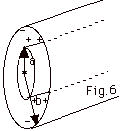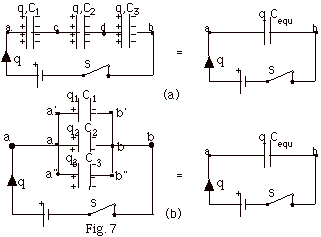|
Outline - Potential Energy, Potential,
and Capacitors
|
|
- Energy
- Potential Energy Difference, UA - UB,
between points B and A equals the work done WB
 A
by you in carrying a positive test charge q' from B
to A without increasing its kinetic energy. A
by you in carrying a positive test charge q' from B
to A without increasing its kinetic energy.
UA - UB = WB A
= A
= 
For no change in kinetic energy, the magnitude of the object's
velocity must remain constant so that there is no acceleration.
For no acceleration, the net force acting on the object is
zero. The vector sum of your force F and the force
Fe exerted by the electric field must be
zero.
Fnet = F + Fe =
F + q'E = 0 or
F = - q'E and
UA - UB = WB A
= A
= 
- Potential Difference VA - VB = VAB
equals the potential energy difference divided by q', or :
VA - VB = VAB = (UA
- UB)/q' = 
- Potential Energy U at a point P equals the potential energy
difference between that point P and some point where the potential
energy is taken to be zero.
- Potential V at a point P equals the potential energy at
point P divided by q', or :
V = U/q'
- Finding electric field from the potential function
Since V = - ∫ E dr, -dV/dr = E.
If you know V, you can find the components of the electric
field from the negative partial derivative of V for that component
(x, y, z, r, Q, and so
forth).
- Finding potential energy and potential functions from

- For point charge, E = kQ/r2. Take U(B)
= 0 when rB = ∞.

Note: U is the potential energy of a system that consists
of two or more charges. V is the potential at a point P due
to a single or more charges.
- You find the potential due to a group of point charges by
finding the potential due to each one, assigning a plus sign
for a positive charge and a negative sign for a negative charge.
Since potential and potential energy are scalar quantities,
the resultant potential or potential energy is the algebraic
sum of the individual potentials or potential energies. In
Fig. 1 below, VP = kq1/r1
- kq2/r2.

- For an extended distribution of charge, take an element
of charge dq.
dV = kdq/r. Integrate to find V for a given situation.

- As an example of an extended distribution take the case
of positive charge spread uniformly along a semicircle
(Fig. 2 above). You wish to find the potential at the
center, point P, of the circle of radius R. For
the element of length ds with charge dq,
dV = kdq/r = kdq/R.
V = k/R ∫ dq = kQ/R,
where Q is the total charge on the semi-circle.

- A more complicated problem is shown in Fig. 3 above
because the distance r from the element of charge is a
variable. The element of charge dq on the element of length
dx is the charge per unit length times dx, or dq = l
dx. For any element dV = k dq/r = k l
dx/r.
The problem here is you have two variables, r and x, and
you must put one in terms of the other, plus a constant.
But r = (x2 + y2)1/2,
where y, the Y-coordinate of P, is a constant.
Then dV = kl dx/r
= kl dx/(x2
+ y2)1/2

- Calculation of potential difference for distribution of charges
- Parallel plate capacitor (Fig. 4)

This capacitor is used so frequently that it is worth considering
again. For one "infinite" plane E = s/2eo,
where s = q/A. For
the parallel plate capacitor, both plates produce an electric
field to the right (the direction in which a positive test
charge is urged) and the electric field between the plates
E = s/eo.
The potential difference between the plates,

since E = s/eo,
Va - Vb = sd/eo
- Concentric sphere and shell (Fig. 5)

If the sphere of radius a is a conductor, the electric field
for r < a is zero. Whether it is a conductor or not, the
electric field for a > r < b is due only to the charge
enclosed by a Gaussian surface with a < r < b. Also
the sphere of radius a acts like a point charge Q at the center
of the sphere and the electric field E = kQ/r2.

- Coaxial cylinders (Fig. 6)
 |
The electric field
between the cylinder of radius a and the cylindrical
shell of radius b is due only to the charge on the inner
cylinder, as illustrated in Fig. 6.
For a < r < b, E = l/2peo |

- Capacitance
- Definition C = q/Vab.
C is a constant that depends only on the geometry of
the capacitor.
- For parallel plate capacitor,
C = q/Vab = q/(sd/eo)
= sA/(sd/eo)
= eoA/d
= a constant depending only on geometry of capacitor.
- For sphere and concentric spherical shell,
C = q/Vab = q/[q(b - a)/4peoab]
= 4peoab/(b
- a).
C is a constant that depends only on the geometry of the
capacitor.
- For coaxial cylinders,
C = q/Vab = q/[(q/L2peo)ln
b/a] = 2Lpeo/ln
b/a
= a constant that depends only on the geometry of the
capacitor.
- Capacitors in series and in parallel

- For the three capacitors wired in series (Fig. 7a above),
- The charge q is the same on each.
- The potential difference across each is not the
same unless the capacitance of each is the same. From
conservation of energy,
Vab = Vac + Vcd
+ Vdb
- Since Cequ = Vab/q,
Vab/q = Vac/q + Vcd/q
+ Vdb/q
- 1/Cequ = 1/C1 + 1/C2
+1/C3, where Cequ is the
equivalent capacitor which replaces the three individual
capacitors and has the same charge q and the same
potential difference Vab. For capacitors
in series, the reciprocal of the capacitances add
to equal the reciprocal of the equivalent capacitance.
- For the three capacitors wired in parallel (Fig. 7b
above),
- The potential difference across each is the same:
Va’b’= Vab
= Va”b”
- From conservation of charge, q = q1
+ q2 + q3
- Since q = CequVab,
CequVab = C1Vab
+ C2Vab + C3Vab
or
Cequ = C1 + C2
+ C3
For capacitors in parallel, the sum of the individual
capacitances equals the equivalent capacitance.
- Energy associated with capacitors
U = 1/2 qVab
Since C = q/Vab, U = 1/2 q2/C
= 1/2 CVab2
- The unit of capacitance is the farad (F). Since C = q/Vab,
1 F = 1 C/1 V.
- Using the parallel plate capacitor, you find the electrical
energy per unit volume stored in an electric field is uE
= 1/2 eo
E2. The electrical energy stored in volume dV
is dUE = 1/2 eo
E2 dV, where dV = 4pr2
dr for a spherical shell and dV = 2prL dr
for a cylindrical shell of length L.
- Dielectrics
All the expressions for electric forces, fields, potential energies,
potential, and capacitance are changed when a dielectric is present.
The symbol e0 is
replaced by ke0,
where k is the dielectric
constant. A dielectric in a medium produces an induced field that
opposes the field set up by the initial charge distribution. The
electric field is decreased, but the capacitance of a capacitor
is increased since k is always
greater than zero.
- Sample Problems in 108
Problem Set for Potential Energy, Potential, and Capacitors:
1 - 6, 8 - 11, 13, 15, 16-19, 22-27.
|
|